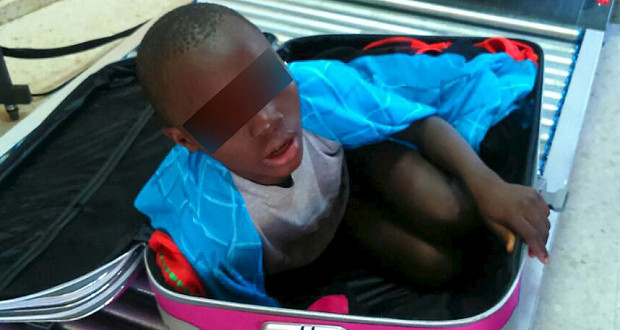PHOTOS: Scan reveals boy in suitcase being smuggled into Spain
- Posted on
- Comment
 An eight-year-old Ivorian child was found hidden in a suitcase that was smuggled across the border into Spanish territory in North Africa, an official said on Friday.
An eight-year-old Ivorian child was found hidden in a suitcase that was smuggled across the border into Spanish territory in North Africa, an official said on Friday.
The child was in a case taken by a 19-year-old woman through a pedestrian crossing from Morocco into the small Spanish-governed territory of Ceuta on Thursday.
“My name is Abou,” the boy said immediately in French when civil guards asked the Moroccan woman to open the wheeled suitcase.
She had aroused suspicion at the Tarajal crossing into the Spanish north African enclave as she seemed uncertain on her approach to the pedestrian checkpoint.
The guards ordered her to place the suitcase on the scanner and the screen operator saw the unmistakable outline of a human form inside.
“It could have ended in tragedy,” the civil guard said, considering that the child may have spent considerable time zipped up inside the case.
The boy was checked by a medical team and is now in the hands of child-protection authorities in Ceuta. They will attempt to identify him and ascertain his family connections.
Later that day a 42-year-old man from Ivory Coast was detained at the same post. Although the man had Spanish residency papers issued in the Canary Islands, the civil guards asked about his family and showed him a photograph taken of Abou in the suitcase.
The civil guard said the man confessed to trying to have his son smuggled into Spain.
“I just wanted to take him to the Canaries with me,” the man, identified only as A.O., is reported to have said.
A.O. was arrested and is due to testify before a judge on suspicion of human trafficking.
The Moroccan woman, identified as F.E.Y., was also arrested.
Every day, thousands of women cross the border from Morocco into Ceuta and Spain’s other enclave, Melilla, to collect goods from Spanish businesses and carry them back into Morocco.
Spanish border patrols caught 12,549 illegal immigrants last year, most of them in Melilla and Ceuta and including 3,000 Syrian refugees.
For migrants from West African countries who wish to head for Spain, there are two dangerous and long routes to reach Morocco. One is an inland route crossing Mali and Algeria before entering northern Morocco and heading for the forests near one of the Spanish enclaves.
From there, many attempt to scale the six-metre wire fences, smuggle themselves into Spain or pay to cross the Strait of Gibraltar in a small boat.
The other method is to travel up the coast of Senegal and Mauritania.
Between 2005 and 2006, some 30,000 sub-Saharan immigrants reached the Canary Islands in long, narrow fishing vessels. The civil guard said it was possible that A.O. reached the Canaries in that way, now having become a resident of Gran Canaria.
The UN’s ACNUR refugee organisation estimated that between 1998 and 2011, some 20,000 migrants had drowned in the waters between North Africa and Spain.
Spain has been criticised by organisations such as Amnesty International and the Council of Europe for handing migrants who jump the fence over to Moroccan authorities without any due process or offering them the opportunity to request asylum.
In Ceuta, a judicial inquiry is ongoing into the role of civil guard officers in the drowning of 15 migrants on February 6, 2014. A group of Africans attempted to swim around a breakwater marking the border between Morocco and Spain as Spanish guards fired smoke canisters and rubber bullets in their direction.
-telegraph.co.uk











 (Selorm) |
(Selorm) |  (Nana Kwesi)
(Nana Kwesi)